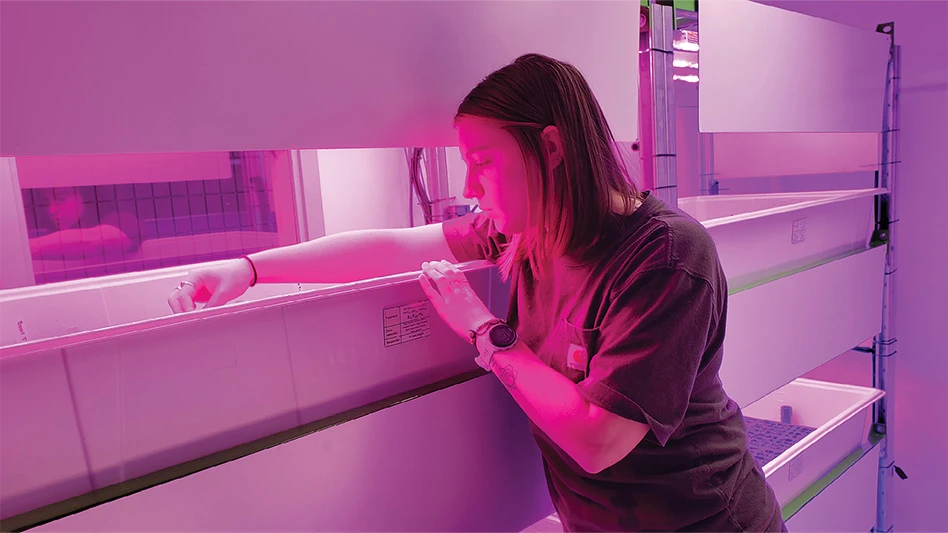Phosphonate fungicides were introduced into the United States during the 1980s when Rhone Poulenc (now Bayer) launched Aliette 80WP. These products were better known in other countries, especially Australia, where they were extensively researched and in commercial use.
The most interesting fact about this chemical group is that its mode of action was not fully understood at the time the fungicides were introduced into agricultural use. The phosphonates have been described as having “systemic acquired resistance” (SAR) characteristics. This means that when exposed to the compound before infection, plants react by activating their natural defense mechanisms enabling the plants to fight off disease to some degree.
Effective disease control
Aliette, at least, has also been demonstrated to have direct effects on some pathogens including Phytophthora and Pythium. Many of the phosphonates have been shown to help control active downy mildew infections. Aliette and the phosphonates have documented efficacy on oomycete fungi including downy mildews (i.e., Peronospora), Phytophthora and Pythium.
Nearly all of the phosphonate research that has been reported in the past 20 years involves Phytophthora as the primary target pathogen. However, a review of the literature shows that oomycetes are not the only targets for phosphonates. Researchers have reported efficacy on apple scab (Venturia), Phomopsis dieback on grape vines, Monilinia (in Petri dish studies), Colletotrichum leaf spot (anthracnose) on beans, alfalfa mosaic virus on beans, Rhizoctonia damping-off on wheat, Uromyces rust on bean and Fusarium wilt on certain crops. Control of Sclerotinia (dollar spot) on turf was very good with one phosphonate and actually better than an industry standard in the same trial. Control of bacterial shot hole on plum caused by Xanthomonas campestris pv. pruni was as effective with a phosphonate as an industry standard and actually safer to use than the standard and copper.
Common phosphonates
Some of the most common phosphonates with fungicide labels for ornamentals are listed in Table 1. Since Aliette came off patent, the market has seen a proliferation of phosphonate products including Avalon which is the most similar to Aliette. The labels for these two products reflect their similarity with the only 12-hour re-entry interval (REI) in the group. Each of the other phosphonates reviewed for this article has a four-hour REI. Each is also labeled for drench applications with slightly different rates based on their specific formulation.

It was interesting to review labels to determine which pathogens (or diseases) were included. Vital is listed for Pythium, Phytophthora, Xanthomonas and downy mildew. Aliette and Magellan are also registered for suppression of fire blight (Erwinia amylovora) and Aliette lists suppression of Xanthomonas campestris pathovars. Alude is listed for all of these as well as apple scab and mycosphaerella (gummy stem blight on cucurbits). K-Phite adds powdery mildew and Fusarium to those diseases listed for Aliette. Fosphite includes the longest list of pathogens or diseases: downy mildew, Phytophthora, Pythium, powdery mildew, Fusarium, Rhizoctonia, fire blight, Xanthomonas and Ralstonia. Regardless of their labels, most phosphonates are used for Phytophthora, Pythium and downy mildew.
Phosphonate trials
Table 2 summarizes the results of Chase Horticultural Research studies with phosphonates over the past 10 years. Most product applications were made as sprays for foliar diseases and drenches for root diseases. Some of the trials were done on more than one crop type and pathogen. For instance, control of Pythium on calla lilies and snapdragons showed different results. Also, Phytophthora aerial blight vs. Phytophthora root rot gave different results. These results could not be predicted.

The downy mildew research was not variable even though a lot of different hosts were tested. Pansy, snapdragon, stock, statice, salvia and rose were included in at least one trial. Overall, phosphonates work very well on the oomycetes but also give good control of bacterial leaf spots and good to excellent control of powdery mildew. In a series of black spot on rose trials in Alabama, Aliette generally was equivalent to unsprayed controls. No meaningful control of Alternaria leaf spot or Botrytis blight was achieved.
Bacterial disease control
As a professor at the University of Florida during the 1980s and early 1990s I worked extensively on Aliette for bacterial disease control. It provided good control of Pseudomonas and Xanthomonas leaf spots but no real control of Erwinia soft rot.
In the past 10 years, the efficacy of some other phosphonates on Xanthomonas blight of stock (Matthiola incanae) has been studied. Some control was achieved with all treatments, but the best control occurred when plants were treated with Kocide TNO, but the phosphonates were statistically equivalent.
Another trial with Xanthomonas blight on ranunculus compared an experimental phosphonate to Camelot (20 ounces per 100 gallons) and Phyton 27 (20 ounces per 100 gallons). Both Camelot and Phyton 27 provided good control with the experimental phosphonate supplying slightly less control. All three products were significantly better than the inoculated control, but not that different than each other and not as good as the non-inoculated control. Aliette was tested for fire blight prevention on cotoneaster, but failed to be effective.
Most recently, research conducted by plant pathologist David Norman at the University of Florida demonstrated the value of using two phosphonates as preventive drenches to protect geranium plants from bacterial wilt caused by Ralstonia solanacearum. The study with Aliette and K-Phite did show a high degree of efficacy. Phosphonates do provide similar control to Aliette on some bacterial leaf spots and bacterial wilt on geranium.
Phosphonates are unique in their ability to reduce some diseases by direct action as well as indirect action as a systemic acquired resistance initiator. They are very effective against oomycete diseases including Phytophthora aerial blight and downy mildew. They also work very well at times on Pythium root rot and powdery mildew as well as some bacterial leaf spots.
Be sure to follow label directions. Do not mix phosphonates with copper products or alternate these two chemical class products on less than a seven-day interval. In some cases the phosphonate product (i.e., Aliette especially due to low pH) allows more copper to become available and copper toxicity can result.
A.R. Chase is president, Chase Horticultural Research Inc., (530) 620-1624; www.chasehorticulturalresearch.com.

Explore the September 2010 Issue
Check out more from this issue and find your next story to read.
Latest from Greenhouse Management
- CEA Alliance celebrates bipartisan introduction of Supporting Innovation in Agriculture Act
- Dümmen Orange North America celebrating 25th anniversary in 2025
- CEA HERB Part 1: Best management practices for culinary herbs
- Lawsuit challenges new H-2 visa rules
- CEA HERB Part 2: A guide to increasing the sowing density of culinary herbs
- Illinois Landscape Contractors Association changes name to Landscape Illinois
- 2025 Proven Winners Horticulture Scholarship applications now open
- ICL’s Gemini Granular herbicide now registered for use in California







